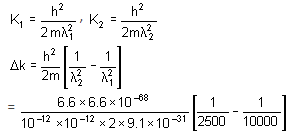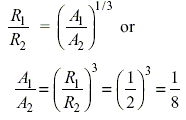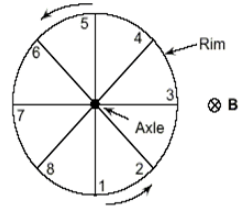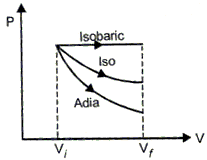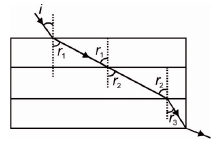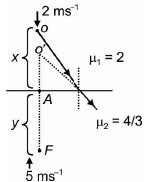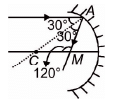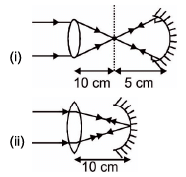NEET Practice Test - 10 - NEET MCQ
30 Questions MCQ Test - NEET Practice Test - 10
A ball falling freely from a height of 4.9 m hits a horizontal surface. If e = 3/4, then the ball will hit the surface for the second time after _________. (Take g = 9.8 m/s2)
A source and an observer are approaching each other with 50 ms-1 velocity. What will be the original frequency if the observer receives 400 cycles/s? Take speed of sound = 340 m/s
In a potentiometer circuit, there is a cell of resistance 5 ohms and emf 2 V connected to a uniform wire of length 1000 cm and resistance 15 ohms. The potential gradient in the wire is
Electrons in a certain energy level (n = n1) can emit 3 spectral lines. When they are in another energy level, n = n2, they can emit 6 spectral lines. The orbital speeds of the electrons are in the ratio
A force-time graph for a linear motion of a body is shown in the figure. The change in linear momentum between 0 and 7 s is
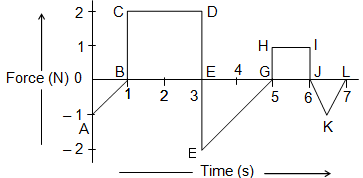
If a coil of 40 turns and area 4.0 cm2 is suddenly removed from a magnetic field, it is observed that a charge of 2.0 x 10-4 C flows into the coil. If the resistance of the coil is 80Ω , the magnetic flux density in Wb/m2 is
To reduce the de Broglie wavelength of an electron from 100 pm to 50 pm, the required increase in energy will be:
Which of the following gates serve as building blocks in digital circuits?
The figure below shows three identical springs A, B and C. When a 4 kg mass is hung on A, it descends by 1 cm. When a 6 kg mass is hung on C, it will descend by
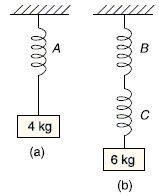
A coil having an inductance of 0.5 H carries a current which is uniformly varying from 0 to 10 A in 2 s. The emf (in volts) generated in the coil is
A nucleus at rest splits into two nuclear parts having radii in the ratio 1 : 2. Their velocities are in the ratio
A metallic wheel with 8 metallic spokes, each of length r, is rotating at an angular frequency ω in a plane perpendicular to a magnetic field B. The magnitude of the induced emf between the axle and the rim of the wheel is
Starting with the same initial conditions, an ideal gas expands from volume V1 to V2 in three different ways. The work done by the gas is W1 if the process is isothermal, W2 if purely isobaric and W3 if purely adiabatic. Then,
A rocket is fired from Earth to the Moon. The distance between Earth and the Moon is r and the mass of Earth is 81 times the mass of the Moon. The gravitational force on the rocket will be zero when its distance from the Moon is
The strength of the magnetic field around a long straight wire carrying current is
An air bubble is inside the water (μwater = 4/3). Which of the following is correct?
A light ray is incident at an angle of 60° at one face of a prism. If emergent ray makes an angle of 30° with the incident ray, then correct statement is (Angle of prism is given as 30°)
An astronomical telescope in normal adjustment receives light from a distant source S. The tube length is now decreased slightly, then
Ratio of intensities of coherent waves in YDSE is 9 : 4. Ratio of intensities of minima to the maxima produced is
It is given that μ1 > μ2 > μ3. Find angle made by the ray of light with the normal in medium of refractive index (μ3).

An object O is moving towards the surface of water with a speed of 2 ms–1 and fish F is moving towards the surface with a speed of 5 ms–1. Find the speed of the object O as seen by fish.

A marginal ray falls upon a concave mirror of radius of curvature 20 cm as shown in figure. Find distance CM (in cm).
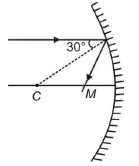
The coordinate of a point where parallel rays are focussed by the thin convex lens is [where focal length of convex lens is 10 cm and it is placed along y-axis]
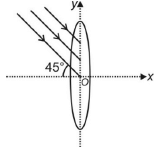
A convex lens forms an image at a distance 10 cm when a parallel beam of light is incident on it. Find the position(s) of a concave mirror of radius of curvature 5 cm such that the final image is formed at infinity
An astronomical telescope has magnification 8 for normal adjustment. A person using this telescope finds that when distance between objective and eyepiece is made 40 cm, the final image is formed at infinity. Select the correct pair of focal lengths of objective and eyepiece respectively.
An unpolarised beam of light is made to incident on an arrangement of four polarising sheets arranged in such a way that the characteristic direction of each polarising sheet makes an angle of 45° with that of preceding sheet. What fraction of incident unpolarised light will be transmitted finally?
thickness t and refractive index μ = 1.5 is placed just in front of upper slit, the central bright fringe shifts to nth bright fringe. Then n is (λ = Wavelength of light in air)
If intensity of principal maximum in Fraunhofer single slit diffraction is I0. Then, intensity of second order secondary maxima is
The de Broglie wavelength of a particle moving with a velocity of 2 × 108 ms–1 is equal to the wave length of photon. What will be ratio of kinetic energy of the moving particle to that of energy of a photon?
Consider a monochromatic linear source of light which is placed at a distance of r from a very small metal plate. Due to photoelectric effect electrons are ejected at rate N per second and it is found that maximum kinetic energy of photoelectron is K. If source is brought closer to a distance r / 3, the rate of emission and the maximum kinetic energy of photoelectron become nearly






